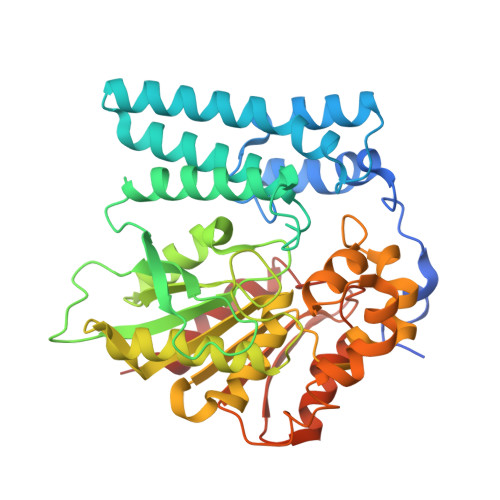Polyketide Trimming Shapes Dihydroxynaphthalene-Melanin and Anthraquinone Pigments.
Schmalhofer, M., Vagstad, A.L., Zhou, Q., Bode, H.B., Groll, M.(2024) Adv Sci (Weinh) 11: e2400184-e2400184
- PubMed: 38491909
- DOI: https://doi.org/10.1002/advs.202400184
- Primary Citation of Related Structures:
8QBH, 8QBI, 8QD1, 8QD2, 8QD3, 8QD4, 8QD5, 8QD6, 8QD7, 8QD8, 8QD9, 8QDA, 8QDB - PubMed Abstract:
Pigments such as anthraquinones (AQs) and melanins are antioxidants, protectants, or virulence factors. AQs from the entomopathogenic bacterium Photorhabdus laumondii are produced by a modular type II polyketide synthase system. A key enzyme involved in AQ biosynthesis is PlAntI, which catalyzes the hydrolysis of the bicyclic-intermediate-loaded acyl carrier protein, polyketide trimming, and assembly of the aromatic AQ scaffold. Here, multiple crystal structures of PlAntI in various conformations and with bound substrate surrogates or inhibitors are reported. Structure-based mutagenesis and activity assays provide experimental insights into the three sequential reaction steps to yield the natural product AQ-256. For comparison, a series of ligand-complex structures of two functionally related hydrolases involved in the biosynthesis of 1,8-dihydroxynaphthalene-melanin in pathogenic fungi is determined. These data provide fundamental insights into the mechanism of polyketide trimming that shapes pigments in pro- and eukaryotes.
Organizational Affiliation:
TUM School of Natural Sciences, Department of Bioscience, Centre for Protein Assemblies, Chair of Biochemistry, Technical University of Munich, 85748, Garching, Germany.














